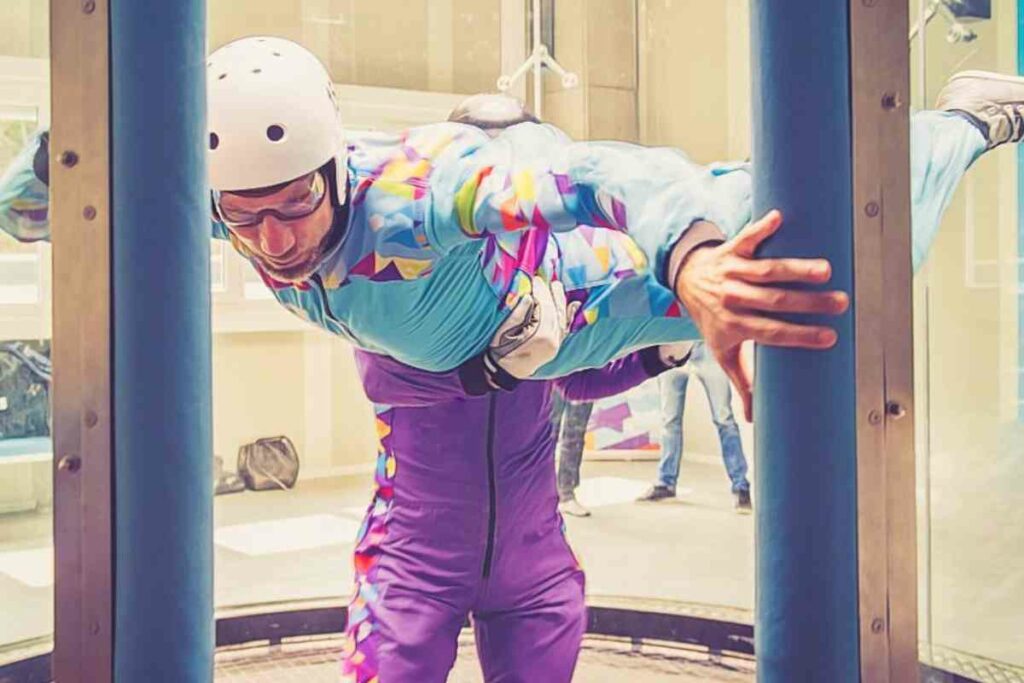They say there’s no other feeling in the world like skydiving. But as exciting as it can be, not everybody is comfortable jumping or falling out of a plane at 10,000 feet.
That’s where indoor skydiving comes in, letting you do a bit more than fly.
Quick Facts About Indoor Skydiving
Indoor skydiving provides the adrenaline rush of skydiving without the jump. But how is that possible?
How does indoor skydiving replicate the feeling of falling through the sky at 120mph?
Indoor skydiving occurs in a vertical wind tunnel, a cylindrical, glass-walled tube with powerful fans at the top or bottom.
Read before you go – Can You Indoor Skydive If You Have a Medical Condition?
The powerful fans draw air into the tunnel and pump it upwards at up to 180 miles per hour.
The winds inside the tunnel are strong enough to levitate a human body through drag, simulating the sensation of free fall.
Indoor skydiving is safer, cheaper, and for many, just as exhilarating as actual skydiving!
Can You Do Tricks And Flips In The Tunnel?
Indoor skydiving opens up possibilities regarding all the movements you can practice in the wind tunnel.
As a first-time flyer, the first thing you have to master is flying stable and balanced on your belly, then start doing tricks.
Here are some of the tricks you can do when indoor skydiving:
- Flipping from your feet
- Spirals
- Side slides
- Fly up to the ceiling (high flight)
- Flying head down and back again
- Laying on the ground
- Walk on the walls of the vertical wind tunnel
However, flips, tricks, and other complex maneuvers are for experienced flyers only for safety reasons.
Don’t expect to be doing these tricks in your first indoor skydiving experience. You need to learn the basic indoor skydiving techniques and make gradual improvements.
Progressing Your Skills in the Tunnel
Like skydiving, wind tunnel flying has a learning curve and a specific progression you will need to follow to skydive like a pro.
You’ll be doing flips, spirals, and other wind tunnel tricks unassisted. But you have to nail down the basics first.
So, how do you progress with your indoor skydiving skills?
Here’s what your indoor skydiving progression should look like.
- Neutral Belly Position. Start your progression by mastering flying on your belly. This is the first thing your instructor will teach you when you go indoor skydiving for the first time.
- Back Flying. You can progress to back flying once you’ve nailed flying on your belly. Your instructor will teach you the neutral and stable back-flying position. You can move to other orientations after you know how to do that.
- Head Up. Immediately you are comfortable with back flying; the next challenge in your progression is learning to fly with your head up. You will learn to maintain a neutral, controlled head-up flying position in the wind tunnel.
- Head Down. You can progress to head-down flight as soon as you have mastered the head-up position (like sitting in a chair). Your instructor will teach you to stay in control when flying with your head down in a sitting position.
Once you’re comfortable flying in a natural belly position, back flying, head up and head down orientations, you are ready for the more complex maneuvers.
You’ll learn the forward flipping technique (bail), back flips, and upward and downward movements during your progression.
Are you eager to learn more? Explore this comprehensive beginner’s guide to indoor skydiving, packed with valuable tips and techniques designed specifically for newcomers like yourself.
Doing Tricks In the Wind Tunnel
With the basics on lock, your instructor may feel it’s time to add wind tunnel tricks to your skillset.
You’ll start with simple tricks such as side slides and the high flight. You’ll also learn how to adjust the surface area you expose to the wind to control flight speed.
You can execute complicated tricks such as the Half Eagle and Full Reverse Eagle as an advanced flyer.
You’ll also be able to move on to performing dynamic movements with other experienced indoor skydivers in a wind tunnel.
Conclusion
Like every other skill worth learning, indoor skydiving takes time and practice to perfect. If you are new to indoor skydiving, focus on the basics and advance.
If you’re a relatively fast learner, you’ll be doing flips and tricks in the wind tunnel in no time.







